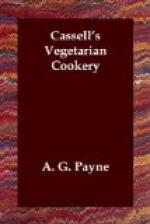PRUNES, STEWED.—The prunes should be washed before they are stewed. They will not take more than half an hour to stew, and a strip of lemon-peel should be placed in the juice. Stewed prunes are much improved by the addition of a little port wine.
PLUMS, STEWED.—Stewed plums, such as black, ordinary, or greengages, or indeed any kind of stone fruit, can be stewed in syrup, and have this advantage—plums can be used this way which could not be eaten at all if they were raw. These fruits are much nicer cold than hot. In many cases, in stewing stone fruit (and this applies particularly to peaches, apricots, and nectarines), the stones should be removed and cracked and the kernels added to the fruit.
CHERRIES, STEWED.—Large white-heart cherries form a very delicate dish when stewed. Very little water should be added, and the syrup should be kept as white as possible, and, if necessary, strained. Stew the cherries till they are tender, but do not let them break. Colour the syrup with a few drops of cochineal, and add a glass of maraschino.
ICES.—Ices are too often regarded as expensive luxuries, and show how completely custom rules the majority of our housekeepers. There are many houses where the dinner may consist daily of soup, fish, entrees, joint, game, and wine, and yet, were we to suggest a course of ices, the worthy housekeeper would hesitate on the ground of extravagance. It is difficult to argue with persons whose definition of economy is what they have always been accustomed to since they were children, and whose definition of extravagance is anything new. The fact remains, however, that there is many a worthy signor who sells ices in the streets at a penny each, and manages to make a living out of the profit not only for himself, but for his signora as well. Under these circumstances, the manufacture of these “extravagances” is worthy of inquiry. Ices can be made at home very cheaply with an ice machine, which can now be obtained at a, comparatively speaking, small cost. With a machine there is absolutely no trouble, and directions will be given with each machine, so that any details here, which vary with the machine, will be useless. Ices can be made at home without a machine with a little trouble, and, to explain how to do this, it is necessary to explain the theory of ice-making, which is exceedingly simple. We will not allude to machines dependent on freezing-powders, but to those which rely for their cold simply on ice and salt mixed. We will suppose we want a lemon-water ice, i.e., we have made some very strong and sweet lemonade, and we want to freeze it. It is well known that water will freeze at a certain temperature, called freezing-point. By mixing chopped ice and salt and a very little water together, a far greater degree of cold can be immediately produced, viz., a thermometer would stand at 32 degrees below freezing-point were it to be plunged into this




